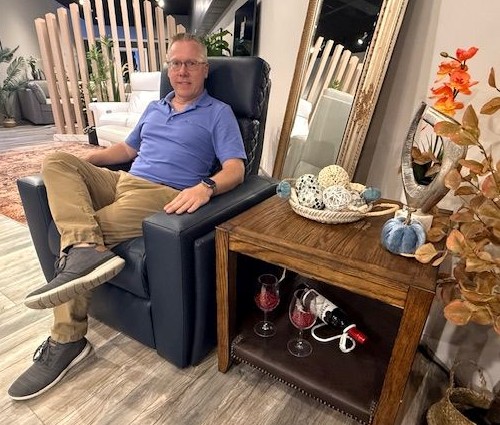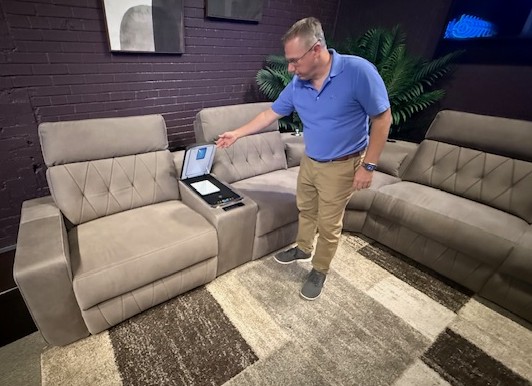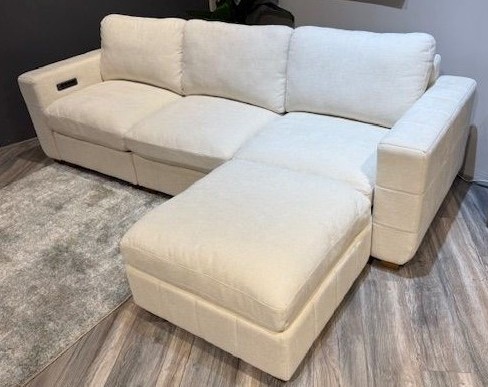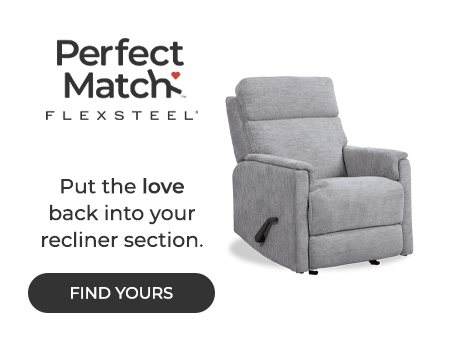In this interview, Home News Now speaks with the president and chief product officer of the upholstery resource whose name partly in all caps is an acronym for Select Members Alliance Revolutionizing Technology. While lengthy in its description, it just scratches the surface in terms of the functionality customers can expect to experience in the motion/modular upholstery line. Carter discusses how he got started in the industry and how he started this particular company along with what makes it unique and meaningful in today’s marketplace for those seeking both comfort and functionality.
HNN: Todd, please tell us and our readers a little bit about your background in the industry, including what drew you to a career in home furnishings?

Carter: While people still tell me I look 35, I stepped into the furniture arena cutting my teeth at Berkline ‘University’ over three decades ago. At the time, I thought it was a steppingstone to something bigger career related. I was blessed with the opportunity to be a part of their Asia sourcing program and ultimately relocated to China around 2007. Having the chance to grow such a network in the import sector, I was fortunate to expand the electronics innovation category with eMoMo, where I had initially gotten my feet wet at Berkline. I think most people will agree that Berkline was a leading pioneer of the motion and power category. I learned from so many of my peers there who are still in the industry today. I owe them my respect for their accomplishments as well.
And can you tell us a little bit about the history of beyondSMART — when it started and how the line has evolved?
Carter: beyondSMART started in late 2017 while developing some products for the AU market. Our parent/partner company eMoMo is a global supplier of electronics and had been primarily focused on upholstered furniture. Some of eMoMo’s customers proposed and challenged us to develop several items specific to customer demands. beyondSMART was born with the intention of building much-needed technology into the furniture industry to meet the growing demand for more function and smart tech in the product. We first launched into the High Point Market in 2018 and exhibited to the benefit of our OEM customers, showcasing the electronic features married together with the upholstery, offering a much better presentation and interactive experience.

As 2020 rolled around and the pandemic put the brakes on most of the new international business, we continued to grow with our AU customers all while keeping in touch with our partners abroad. We launched in our new showroom in April ’22 and have aligned to focus with smaller accounts as well as projects with various Top 50 retailers with offerings we felt were not available at mainstream and with the larger importers.
How would you describe the line today compared with when you first started? Also can you give us an idea of how many SKUs there are currently and what the mix consists of primarily?
Carter: Overall, I can say our design intent and strength has not changed from being a top-tier electronics innovator and we continue to bring new tech ideas and conceptual practices to the industry year after year. Having said that, our line at the onset was more of a modular motion or stationary concept to target millennials who might be starting new homes and families but still craving the tech which they have been brought up with. Today, we have taken a hard look at the market and consumer demand and found that it’s simply not the youth of tomorrow, but Gen X and beyond. We have a broad selection of small-scale pop-up sleeper pieces with integrated power galore and we’ve included much-needed storage consideration. Also our upholstered bed items feature powered tech and functional applications that work great with the adjustable bed market which is another category taking off. Currently we have around 150 SKUs between our online and retail offerings.
There are a number of companies that try to bring functionality and innovation to the living room segment. But from what we have seen, you have taken it to a whole new level. Can you tell us some of the signature elements that separate beyondSMART from the competition?
Carter: I think there are a select few OEM companies out there who get it, and they know this type of technology isn’t something you can simply put a shiny bezel around and win. These things take time, they require testing and certification. Bottom line … it costs money to do it right! We pride ourselves in providing an assortment of smart functionality while pairing it with the correct furniture product. We have found that maybe the conceptual components we bring to market might be ahead of the trend, but instead of riding tailwinds, we prefer to create them.
How did the company approach innovation in the category? In other words, how did the company decide what type of functionality was missing in the marketplace? Were there signature functional elements that have evolved over time?

Carter: We knew early on there was a huge gap in innovation when it comes to tech. The elephant in the room is that retail training as well as consumer knowledge can’t catch up. It’s like giving grandma a pair of meta sunglasses. Sure, your grandmother can buy meta glasses, but who is going to explain what they are and how they can benefit her? We do both. We are crystal clear on every element of our product, what it can do, how it helps in the home and we give retail sales associates the tools so they can to introduce our products and promote them. We want the consumer to learn at their own pace and we have online literature about what they see on the floors or they can utilize QR codes at retail and our sales tags for the more tech savvy. This is where sourcing teams miss the mark, due to their lack of resources or just buying off the shelves in certain cases.
Can you tell us where the line falls in terms of price compared to other similar product in the segment (lower middle, middle, upper middle)?
Carter: Our line falls in the upper middle for the most part — however we do have a few products directed at e-commerce where we need to be competitive at a lower-middle price point.”
How would you describe the response the line has received from retailers of late?
Carter: The response of the product has been great! With tech being a new huge trend we had flexibility within this category to continue to push boundaries. As we started, there was not as much to benchmark or price compare. Even with products on floors, there’s still a large amount of floor space to gain for the smart furniture category. Retailers are still working to understand consumer needs versus the price point ceiling.
As with everyone else in the industry, we are guessing that the timing of tariffs has not made anything easier for the company. Can you say how much they have impacted pricing and what your approach has been in terms of sharing the cost?
Carter: We have obviously made the shift from China when it comes to finished goods production and our development strengths are solid. The supply chain operations have relocated in Southeast Asia. We are looking to other options but as we do the math, until raw material suppliers get ramped up and outfitted elsewhere, Asia is still more sensible.
Is the product available primarily container direct (including mixed containers)? Do you have a domestic warehouse also?
Carter: Now, we are container direct without any warehousing. We offer some mixing depending on volume and assortment. We have found that with electronics, it can become chaotic to mix a multitude of SKUs for both factory as well as customer.”
What is new this market at beyondSMART? Can you us give us a snapshot of how many new pieces you are introducing and any signature core innovations?
Carter: We have made a concerted effort to focus on the products we have developed and to be sure we have met the needs of retailers. This market we decided to update our current offerings with new technology. We are working on a one time a year introduction to be sure we have the right new product for retail. Like large electronics companies, we are staying focused versus churning out products just because there is another market. Every time we introduce a new collection, it is well thought out, researched and tested before an introduction is made.



